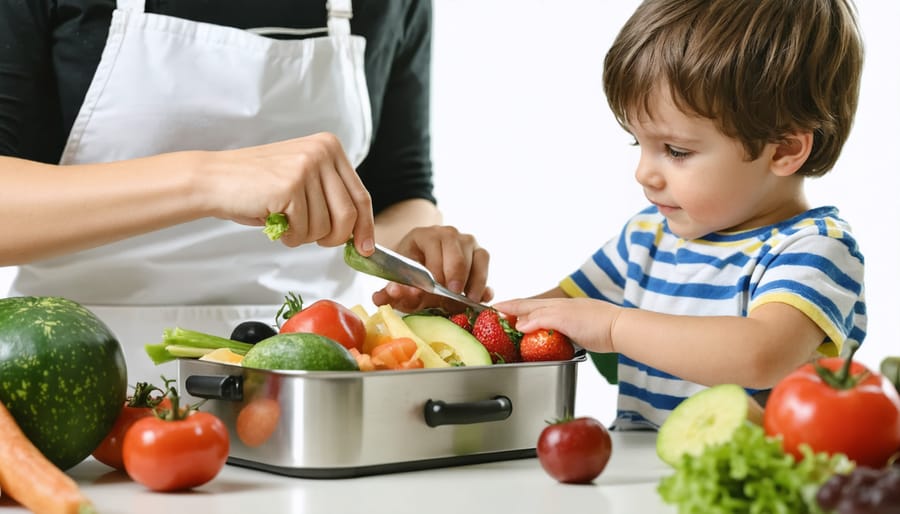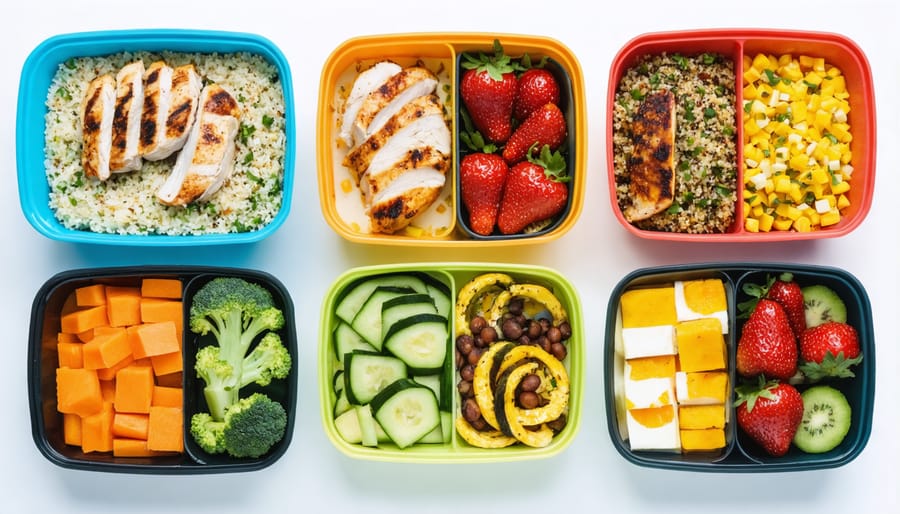
Transform your family’s eating habits with a practical clean eating meal plan that works in the real world – no fancy ingredients or hours of meal prep required. Start by replacing processed snacks with ready-to-grab fruit bowls, pre-cut vegetables, and homemade trail mix stations that kids can access themselves. Create a flexible weekly menu featuring simple swaps like whole grain pasta for white, lean proteins for processed meats, and colorful vegetables in familiar family favorites.
Stock your kitchen strategically by organizing a pantry section dedicated to clean ingredients, making it easier for every family member to make healthier choices. Keep wholesome staples like quinoa, beans, natural nut butters, and fresh produce visible and accessible. Batch cook basics like grilled chicken, roasted vegetables, and whole grains on weekends to assemble quick, nutritious meals during busy weekdays.
Getting the whole family on board doesn’t mean a complete kitchen overhaul or battles at mealtime. Instead, focus on gradual changes, involve kids in meal planning and preparation, and celebrate small victories as your family discovers new favorite foods together. This realistic approach to clean eating ensures lasting habits that work for everyone’s schedule, preferences, and lifestyle.
Why Clean Eating Matters for Your Family
The Real Benefits Beyond the Buzz
When you embrace natural family living through clean eating, the benefits extend far beyond just feeling good about your food choices. Research shows that children who grow up eating whole, unprocessed foods tend to perform better in school and maintain healthier weights throughout their lives. Parents often report increased energy levels and better sleep quality, while many families experience fewer mood swings and improved concentration.
The real magic happens in your body’s inflammatory response – clean eating helps reduce chronic inflammation, which is linked to numerous health conditions. Families who make the switch typically notice clearer skin, stronger immune systems, and more stable blood sugar levels. Plus, children who participate in preparing whole foods develop a healthier relationship with eating and are more likely to maintain these habits into adulthood.
Remember, these benefits build over time, and even small changes in your family’s eating habits can lead to significant improvements in overall health and wellbeing.
Common Concerns (And How to Address Them)
Let’s tackle those common worries that might be holding you back from embracing clean eating with your family. “My kids are picky eaters!” is probably the most frequent concern I hear from parents. Start by involving your children in meal planning and preparation – it’s amazing how much more willing they are to try foods they’ve helped choose or cook.
Budget concerns? While some clean ingredients might cost more upfront, cooking from scratch often saves money in the long run. Shop seasonal produce, buy in bulk, and plan meals that share ingredients to minimize waste. For busy families wondering about time management, batch cooking on weekends and simple meal prep can be game-changers.
“What if my family resists?” Take it slow – make gradual swaps rather than dramatic changes. Replace processed snacks with fresh alternatives, and experiment with healthier versions of family favorites. Remember, this is a journey, not a race, and small consistent changes lead to lasting habits.
Building Your Family’s Clean Eating Foundation
Clean Eating Shopping List Essentials
Stocking your kitchen with clean eating essentials is like building a strong foundation for your family’s health journey. As a busy mom who’s been there, I’ve learned that having the right ingredients on hand makes it so much easier to stick to clean eating habits.
Start with your pantry basics: whole grains like quinoa, brown rice, and rolled oats; legumes such as lentils, chickpeas, and black beans; and nuts and seeds including almonds, chia seeds, and walnuts. These items have long shelf lives and form the backbone of many nutritious meals.
For natural sweeteners, keep raw honey and pure maple syrup on hand. Stock up on cold-pressed oils like extra virgin olive oil and coconut oil for cooking. Don’t forget herbs and spices – they’re your best friends for adding flavor without artificial ingredients!
In the fresh produce department, focus on seasonal fruits and vegetables. Some hardy staples to always have around include sweet potatoes, onions, garlic, carrots, and apples. For proteins, opt for eggs, wild-caught fish, lean organic meats, and plant-based options like tempeh.
In your refrigerator, keep Greek yogurt, almond milk, fresh herbs, and hummus for healthy snacking and meal prep. Remember, transitioning to clean eating doesn’t mean you need to buy everything at once – start with the basics and gradually build your clean eating pantry as you explore new recipes and find what works for your family.

Kid-Friendly Clean Swaps
Getting kids to embrace cleaner eating doesn’t have to be a battle! As a mom of two formerly picky eaters, I’ve discovered that the key is making simple swaps that feel familiar. Instead of regular potato chips, try baked sweet potato chips or air-popped popcorn seasoned with nutritional yeast for that cheesy flavor kids love. Replace sugary breakfast cereals with overnight oats topped with fresh berries and a drizzle of honey.
For lunch boxes, swap processed deli meats for homemade chicken strips or hard-boiled eggs. Replace white bread with whole grain versions, introducing them gradually by mixing both types initially. When it comes to snacks, trade candy bars for frozen banana “nice cream” or energy balls made with dates and nuts.
My kids’ favorite swap is using Greek yogurt instead of sour cream for dips and toppings – they can’t even tell the difference! Replace sugar-laden fruit drinks with naturally flavored water (add fresh fruit slices) or homemade smoothies. For pasta lovers, try zucchini noodles mixed with regular whole grain pasta, gradually increasing the veggie ratio.
Remember, the transition doesn’t have to happen overnight. Start with one or two swaps and build from there. The key is making these changes feel natural and fun rather than forced. Let your kids participate in choosing and preparing these alternatives – they’re more likely to embrace foods they help create!
Weekly Meal Plan That Works
Breakfast Ideas That Kids Actually Love
Getting kids excited about healthy breakfast can be a challenge, but I’ve discovered some winners that my own children actually request! These clean eating breakfast options are not only nutritious but also fun and delicious.
Start with colorful fruit-and-yogurt parfaits using plain Greek yogurt, fresh berries, and homemade granola. Kids love building their own, which makes breakfast time interactive and enjoyable. Another favorite is “banana sushi” – whole grain tortillas spread with almond butter, wrapped around bananas, and sliced into bite-sized rolls.
Overnight oats are a game-changer for busy mornings. Let kids choose their mix-ins the night before – think fresh fruit, cinnamon, and a drizzle of honey. For protein-packed options, try mini egg muffins loaded with vegetables (yes, they’ll eat them!) or whole grain toast topped with mashed avocado and scrambled eggs.
Don’t forget smoothies! Blend spinach or kale with frozen fruit, banana, and plant-based milk for a breakfast that tastes like a treat but packs a nutritious punch. The best part? These can all be prepped ahead, making hectic mornings smoother for everyone.

Lunch Box Solutions
Packing healthy lunches doesn’t have to be complicated! As a mom of two, I’ve learned that the key is preparing components in advance and mixing and matching throughout the week. Start with a bento-style lunch box, which makes portion control easier and keeps foods separate – perfect for kids who don’t like their foods touching.
Create a “mix and match” system with these clean eating elements:
– Proteins: turkey roll-ups, hard-boiled eggs, chickpea salad, or leftover grilled chicken
– Complex carbs: whole grain crackers, brown rice, quinoa, or sweet potato chunks
– Fresh vegetables: cucumber slices, cherry tomatoes, baby carrots, or bell pepper strips
– Fruits: apple slices, berries, orange segments, or grape clusters
– Healthy fats: avocado, nuts (if allowed), or hummus
Pro tip: Prep vegetables and fruits on Sunday evening, and store them in glass containers. This makes assembling lunches a breeze each morning. Don’t forget to include a fun note or use cookie cutters to shape sandwiches – sometimes presentation makes all the difference in getting kids excited about healthy food!
Remember to keep things cold with an ice pack and use insulated containers for hot foods. These simple strategies have helped my family stick to clean eating, even during busy school days.
Family-Approved Dinner Recipes
Getting the whole family excited about clean eating doesn’t have to be a challenge. After years of experimenting with my own picky eaters, I’ve discovered some foolproof dinner recipes that never fail to bring smiles to the table.
Our family favorite is the build-your-own taco bowl, featuring seasoned ground turkey, black beans, brown rice, and a rainbow of fresh toppings. Kids love having control over their portions and ingredients, while parents appreciate the wholesome ingredients.
Another crowd-pleaser is the “hidden veggie” turkey meatballs served with whole grain pasta. Packed with finely chopped spinach and carrots, these meatballs are so delicious that kids forget they’re eating vegetables. Pro tip: Make a double batch and freeze half for busy weeknights.
Sheet pan chicken fajitas are perfect for hectic evenings. Simply arrange chicken strips, bell peppers, and onions on a pan, season with mild Mexican spices, and roast until perfectly tender. Serve with whole grain tortillas or cauliflower rice for a clean eating twist.
Don’t forget the classic sweet potato mac and cheese, made with whole grain pasta and a creamy sauce that gets its golden color from nutrient-rich sweet potatoes. It’s comfort food that nourishes both body and soul, and I’ve yet to meet a child who doesn’t ask for seconds.
Remember, the key to family-approved clean eating is making familiar favorites with better ingredients, not completely overhauling your menu overnight.
Healthy Snacks for Busy Days
When life gets hectic, having nutritious snacks ready to grab can make all the difference in maintaining your clean eating goals. I keep our pantry stocked with fresh fruit, nuts, and cut vegetables for those moments when hunger strikes between meals. One of my family’s favorites is apple slices with almond butter, which takes just seconds to prepare.
For on-the-go situations, pack small containers with trail mix combining raw almonds, walnuts, and unsweetened dried fruit. Hard-boiled eggs make perfect protein-rich snacks that can be prepared in advance. My kids love homemade energy balls made from dates, oats, and nut butter – they’re perfect for afternoon activities or post-school hunger pangs.
Keep Greek yogurt cups, cucumber slices, and hummus in the fridge for quick access. These wholesome options help avoid processed snacks while keeping everyone satisfied until the next meal.
Making It Work in Real Life

Meal Prep Shortcuts
As a busy mom of two, I’ve learned that meal prep doesn’t have to eat up your entire Sunday. The key is working smarter, not harder! Start by washing and chopping all your vegetables as soon as you get home from grocery shopping. Store them in clear containers at eye level in your fridge – this makes it super easy to grab and go throughout the week.
One of my favorite time-savers is the “cook once, eat twice” method. When making quinoa or brown rice, double the portion and freeze half for next week. The same goes for grilled chicken – cook extra and slice it up for salads, wraps, or quick protein additions to meals.
Invest in quality storage containers and label everything with dates. A simple sticky note system can work wonders! Get the kids involved by having them help sort ingredients into meal-specific containers. This not only saves time but teaches them about healthy eating habits.
Use your kitchen appliances strategically. While the oven’s roasting vegetables, use the stovetop for protein and the rice cooker for grains. Sheet pan meals are another lifesaver – simply arrange your proteins and veggies on one pan and let the oven do the work while you help with homework or tackle other tasks.
Handling Special Occasions
Special occasions don’t have to derail your family’s clean eating journey. As someone who’s experienced the challenges of managing real mom life, I understand the importance of finding balance during celebrations.
The key is planning ahead while allowing room for flexibility. When attending parties or holiday gatherings, offer to bring a clean dish that everyone can enjoy. This ensures you’ll have at least one healthy option available while sharing your clean eating journey with others.
For birthday parties and school events, focus on the celebration rather than the food. Talk to your children about making mindful choices without creating anxiety around treats. Consider keeping homemade clean alternatives in your freezer for unexpected occasions.
During holidays, maintain your regular clean eating routine for most meals, but allow space for traditional family favorites. Try healthier versions of classic recipes – like using maple syrup instead of refined sugar in baking, or incorporating more vegetables into traditional dishes.
Remember, occasional indulgences won’t undo your family’s healthy habits. The goal is creating sustainable lifestyle changes, not perfection. Celebrate special moments while staying true to your clean eating values most of the time.
Starting your family’s clean eating journey might feel overwhelming at first, but remember that every small step counts. When I first transitioned my own family to cleaner eating habits, we started with just one meal a week and gradually built from there. Today, it’s become second nature for us, and I’ve seen such positive changes in our energy levels and overall well-being.
Begin by making simple swaps in your current meals rather than overhauling everything at once. Replace processed snacks with fresh fruits, or switch white rice for quinoa. Get your kids involved in the process – let them help with meal planning, grocery shopping, and even food preparation. This involvement often makes them more excited about trying new, healthier foods.
Don’t forget to be patient with yourself and your family members. There might be some resistance initially, but consistency and creativity are key. Celebrate small victories, like when your picky eater tries a new vegetable or when everyone enjoys a wholesome meal together.
Remember that clean eating isn’t about perfection – it’s about progress. Some weeks will be better than others, and that’s perfectly okay. Start with the meal plans we’ve discussed, adapt them to your family’s preferences, and make adjustments as needed. The most important thing is to take that first step toward healthier eating habits for your family.
You’ve got this! Your journey to cleaner eating starts right now, and your family’s health will thank you for it.



